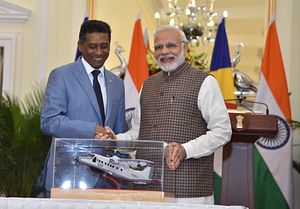After all the hullabaloo about the state of India-Seychelles ties in the Indian media, no dramatic deceleration was evident if one looks at the outcome of the visit of Seychelles President Danny Faure to India this week. On the much-discussed Assumption Island project, while Indian Prime Minister Narendra Modi suggested that the two nations “have agreed to work on the Assumption Island project based on each other’s rights,” Faure made it clear that the two nations remain engaged and “will work together bearing each other’s interests [in mind].” It is clear that despite the domestic turbulence in the Seychelles on the issue, both sides recognize the need to maintain a level of engagement which their convergent interests in the Indian Ocean region demand.
Beyond the Assumption Island project, India decided to extend a $100 million line of credit and gift a Dornier aircraft to the Seychelles. Other pacts signed during Faure’s visit include a white shipping agreement, a twinning agreement between Panaji and Victoria in the Seychelles, a cybersecurity pact, and pacts on exchanges between the Foreign Service Institute and the Seychelles foreign office as well as cultural exchanges. The gamut of these agreements signifies clearly the expansive nature of India-Seychelles engagement, something which was seemingly lost during the furor over Assumption Island.
In some ways, this was natural as Faure’s visit was preceded by his government acknowledging that it would not present the $500 million Assumption Island agreement for ratification to the Seychelles parliament after it came under criticism from the opposition. The pact was signed in 2015 during Modi’s visit and was viewed as important in helping India enhance its strategic outreach into the Indian Ocean. It involved the development of an airstrip, jetty, and housing infrastructure for the Seychelles Coast Guard. As explained by the Indian Ministry of External Affairs, the aim of the project was “to assist Seychelles secure the vast EEZ, including near Mozambique Channel, located over a thousand kilometers from the main island of Mahe.”
Two islands – Agalega in the Mauritius and Assumption in the Seychelles – have been seen as strategically critical for India in the Indian Ocean region as (along with an Indian listening post on Madagascar, off the coast of Africa, commissioned in 2007) they can enhance India’s maritime domain awareness. India can effectively monitor the presence of foreign navies in the Indian Ocean region and at a time when the Indian Ocean waters are becoming more contested by the day, this is key for Indian naval planning. France adds another layer to this equation. Indo-French maritime cooperation is growing, as was underlined by the recent pact providing for the use of each other’s military facilities, including opening naval bases to warships. France’s historical relationship with the Seychelles could make India-France-Seychelles a key maritime partnership in the Indian Ocean region.
That was not to be, however. Domestic political calculus in the Seychelles has sunk the Assumption project for the time being. But the doom and gloom surrounding the discourse on the Seychelles in India is certainly not in sync with the health of the bilateral relationship, as evidenced during Faure’s visit. Faure has clearly indicated that he remains keen on taking the Assumption deal forward and India has indicated that it will be patient as the Seychelles resolves the issue domestically.
The China factor is certainly an important aspect of Indian outreach in the Indian Ocean region. Beijing’s involvement in the development of deep-sea ports in a string of littoral states in India’s neighborhood has been a cause of concern for New Delhi. China established its first overseas military base in Djibouti last year near the Bab el-Mandeb Strait, one of three critical Indian Ocean arteries. And then the acquisition of Hambantota port in Sri Lanka further added to Indian anxieties.
But India’s ties with the Seychelles go beyond China. The two have shared a robust defense engagement after signing an MoU on defense cooperation in 2003. India has been steadily building maritime capability of the Seychelles by donating helicopters, maritime surveillance aircraft, and patrol boats. The Modi government has also articulated a policy of striving for better cooperation among Indian Ocean nations as part of its SAGAR (Security and Growth for All in the Region) initiative. This policy is embedded in New Delhi’s vision “to seek a climate of trust and transparency; respect for international maritime rules and norms by all countries; sensitivity to each other’s interests; peaceful resolution of maritime security issues; and increase in maritime cooperation.” As a pre-eminent power in the region, it is for India to convince its partners that it is willing to bear the burden of their security and economic expectations.
As such, despite some turbulence, India will have to keep on persisting in its engagement with its Indian Ocean partners. China’s presence adds another layer of complexity in the wider Indian Ocean region but even if China were not there, India would be facing headwinds from the complex domestic political climate of its neighbors. New Delhi has done well in reassuring Faure that despite the temporary setback on Assumption Island, it will continue to work with the Seychelles in building its capabilities. Similarly the Seychelles president was prudent enough to recognize that with or without Assumption, India’s role in his country will remain second to none. And so he has promised to keep on working toward generating a more convergent maritime vision.
The challenge for India in the Indian Ocean region is to keep on persevering in building a regional order that remains conducive to not only its own peace but also its neighbors’ security and prosperity.

































